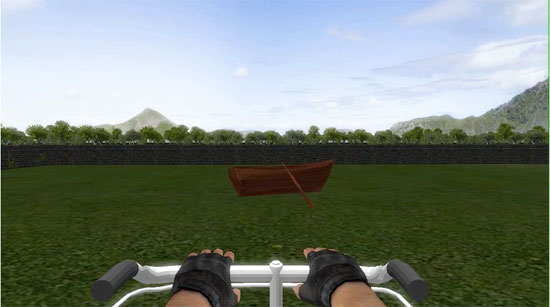Human brain has internal GPS
A type of brain cell, which helps animals track their position in space, was first found in humans.
Scientists discover nerve cells , called grid cells, while activating the brain of game participants to explore the virtual environment. These cells act as an internal GPS system, which also plays a role in human memory.
Researcher Joshua Jacobs, of Drexel University in Philadelphia, said: 'Grid cells help people feel their position in the environment.'
In the late 1970s, scientists found the activity of nerve cells in the hippocampus brain region (the brain's memory center) in mice when it was present in a specific location. This cell is named 'place cell'. In 2005, scientists discovered grid cells in mice, bats and monkeys.

Virtual reality game navigation screenshots.(Photo: upenn.edu)
A study of magnetic resonance imaging on the human brain shows that grid cells exist on humans. This new study is proof that the previous question is true.
Jacobs and his colleagues activated reticular cells by using electrodes implanted in the brains of patients undergoing drug-resistant epilepsy (electrodes used to help doctors find the source of a patient's seizure. ).
To perform the experiment, participants will play a game exploring the virtual environment. They have the task of locating different objects, such as a bottle of water or a bicycle. The object will then disappear, the participant must find the previous position of the object using the joystick.
From the study, scientists discovered the activity of reticular cells in a brain region called the entorhinal cortex, which is involved in memory and is affected by Alzheimer's disease. This finding helps clarify how people move. Humans use the same positioning mechanism as mice and other animals.
"The results help us explain many of the diseases associated with spatial orientation, people with Alzheimer's often become disoriented ," Jacobs said. "Perhaps the treatments will mainly affect grid cells'.
- Published a map of human brain
- The brain and the wonders
- Shocking facts about the human brain
- 15 incredible facts about the brain
- 'Human brain' for the computer
- Set up the first 3D model of the human brain
- Successfully cultured human brain in the laboratory
- America spent 100 million USD to discover the secret of human brain
- Brain human brain worms breed?
- Amazing things about the human brain
- How do we use the brain?
- Does the fly brain work like a human brain?
 Green tea cleans teeth better than mouthwash?
Green tea cleans teeth better than mouthwash? Death kiss: This is why you should not let anyone kiss your baby's lips
Death kiss: This is why you should not let anyone kiss your baby's lips What is salmonellosis?
What is salmonellosis? Caution should be exercised when using aloe vera through eating and drinking
Caution should be exercised when using aloe vera through eating and drinking Why do we get older when cells are always replicating?
Why do we get older when cells are always replicating?  Shocking Research: Human Memory Doesn't Exist Only in the Brain
Shocking Research: Human Memory Doesn't Exist Only in the Brain  Reasons for easy weight gain: Obesity has 'memory' and retains mechanisms in cells
Reasons for easy weight gain: Obesity has 'memory' and retains mechanisms in cells  What happens to cancer cells after they die?
What happens to cancer cells after they die?  New Breakthrough: 'Hack' Tumors, Turn Cancer Cells Into Pills
New Breakthrough: 'Hack' Tumors, Turn Cancer Cells Into Pills  Scientists find a way to trick cancer cells into 'committing suicide'
Scientists find a way to trick cancer cells into 'committing suicide' 